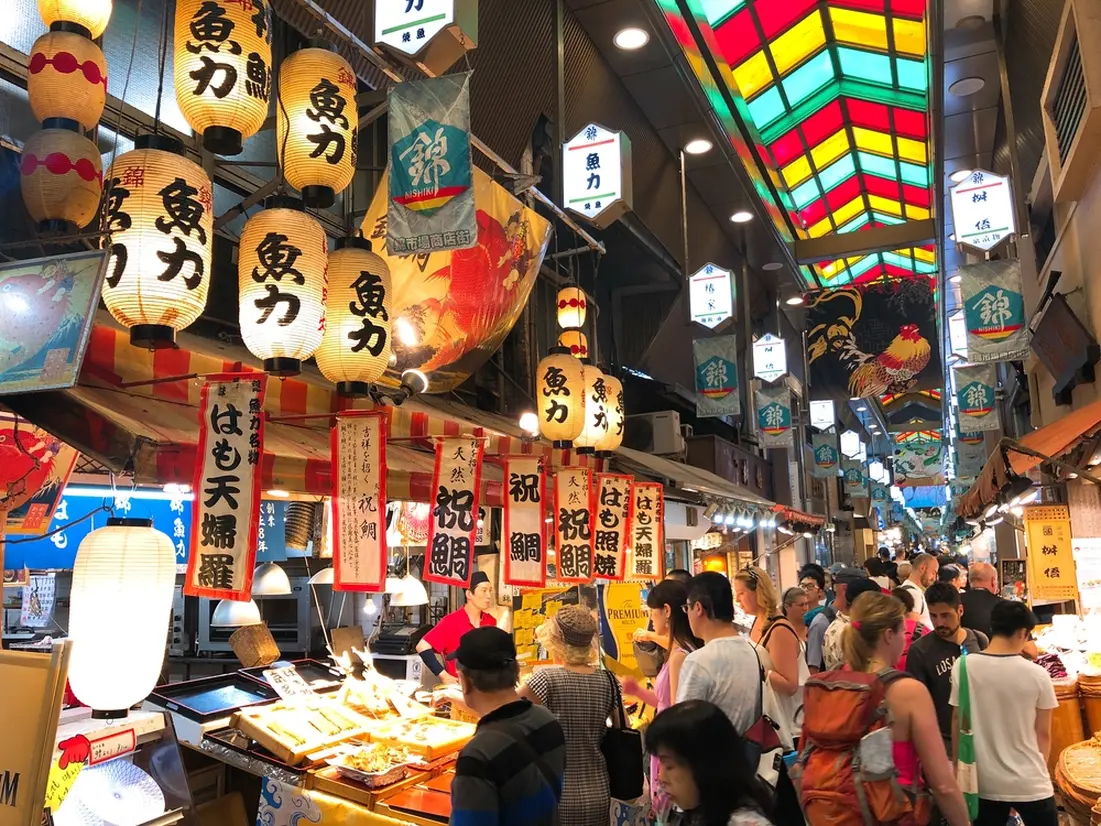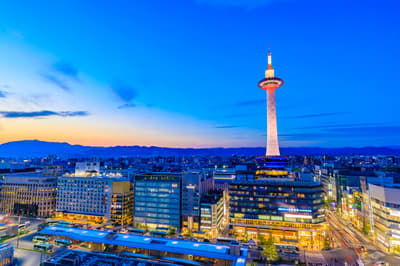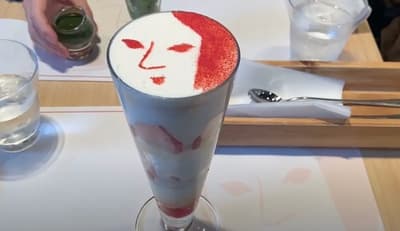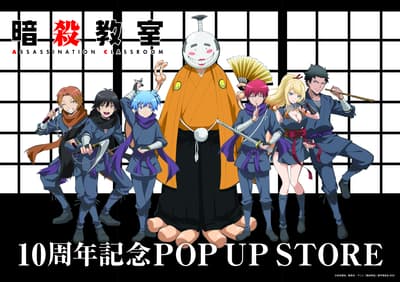The area around Karasuma-Oike, Shijo-Kawaramachi, and Nijo-jo Castle is the busiest district in Kyoto City. Department stores, apparel stores, restaurants, and other stores line the streets, and the latest Kyoto trends are concentrated here. However, it is not all new, which is typical of Kyoto. The Nishiki Food Market has a history of about 400 years, the alleyways have a Kyoto-like atmosphere, and there is a mix of old and new, from long-established stores to stores that are using modern architecture from the Meiji era.
In this issue, we will introduce 10 such spots you should visit around Karasuma-Oike, Shijo-Kawaramachi, and Nijo-jo Castle!
Kamogawa Noryo-Yuka (鴨川納涼床)

Kamogawa Noryo-Yuka is a yuka (raised floor) along the Kamogawa River where visitors can enjoy their meals. It is said to be a summer tradition in Kyoto, and is usually open only from May to September, but recently it has been extended to October in some cases.

If you start your meal just before sunset, you can enjoy the sight of the sky as the sun gradually sets and the lights of the city reflected on the riverside. Although Japanese food tends to be the most popular type of Noryo-Yuka, the Kamogawa River offers a wide variety of restaurants, including French and Italian restaurants.
Pontocho (先斗町)

Pontocho is a narrow north-south street along the Kamo River from one street south of Sanjo Dori to Shijo Dori. The narrow alleys are lined with restaurants, ranging from traditional restaurants and tea houses to Italian restaurants and bars. The narrow streets lined with lanterns are very Kyoto-like, and you can feel Kyoto just by walking down the street.

Ponto-cho used to be a place where there were teahouses where geiko and maiko performed their arts. Although these stores are closed now, a theater called Pontocho Kaburenjo, where geiko and maiko perform dance performances, still remains on the north side of the street. The theater is open to the public every year in May as “Kamogawa Odori”.
Kiyamachi Dori (木屋町通)

Kiyamachi Dori refers to the street stretching north to south along the Takase River from Nijo to Gojo. Along the Takase River, cherry and willow trees are planted, creating an emotional atmosphere. It is a perfect street for a peaceful stroll with stone bridges, retro coffee shops, and fashionable cafes.

At night, however, Kiyamachi has a downtown atmosphere with many pubs and bars lit up and the voices of many people passing by. The difference in atmosphere between day and night is the charm of this street.
Nishiki Food Market Shopping Street (錦市場商店街)

Also known as “Kyoto’s kitchen,” this shopping street has become a tourist attraction crowded with tourists and students on school excursions. It is also popular among foreign tourists as a spot where they can feel the bustling atmosphere of a good old Japanese shopping street.

Within the 390-meter-long street, food items to take home as souvenirs such as kyoyasai (Kyoto vegetables), Japanese Pickles, tofu, and seasonal ingredients are sold, and there are also gourmet foods that can be eaten on the spot, making it easy to stop at each store one by one. The market also has a roof over the ceiling, making it a great spot to visit on rainy days.
Nishiki Tenmangu Shrine (錦天満宮)

Nishiki Tenmangu Shrine sits directly in front of Nishiki Food Market. As the only shrine in the downtown area, it is affectionately called “Nishiki no Tenjin-san” by the locals. The unique feature of this shrine is the stone torii gate in front. The upper edge of the torii gate is buried by buildings on either side. It is said that this was an error made when the area was rezoned, but the fact that the torii gate was not cut down shows Japanese piety. The lanterns at the entrance and on the grounds are also fantastic and very photogenic.
The Museum of Kyoto (京都文化博物館)
If you want to learn about the history and culture of Kyoto, go to the Museum of Kyoto. The museum’s permanent collection introduces Kyoto in various periods from the Heian period to the modern era. In addition, special exhibitions are held periodically, and visitors can view exhibits based on themes.
The red brick annex was built in 1906 and used as a bank. It is now designated as an Important Cultural Property, and the interior can be toured. A long-established Kyoto coffee shop is also located in one corner, where visitors can enjoy a cup of delicious coffee in the historic store.
In addition, the pavilion also has a “Roji-tenpo,” a restaurant district that recreates a townscape from the late Edo period, where visitors can enjoy shopping and dining.
Kyoto International Manga Museum (京都国際マンガミュージアム)

The Kyoto International Manga Museum is a facility that collects, preserves, exhibits, surveys, and researches manga. Although the words “preservation” and “exhibition” may conjure up images of historical materials on display, 50,000 of the 300,000 manga in the museum’s collection are available for free reading. Moreover, visitors can bring them to the grassy area outside the building and lie down to read them.
The “Manga Expo” corner features Japanese manga translated into English, French, Thai, and other languages, as well as comics published overseas. It is a great place to enjoy manga even if you cannot read Japanese. In addition, on Saturdays and Sundays, workshops for drawing portraits and manga are held, offering a variety of experiences.
SAMURAI and NINJA MUSEUM with EXPERIENCE (サムライ忍者体験ミュージアム)
The SAMURAI and NINJA MUSEUM with EXPERIENCE is an activity museum that not only exhibits antiques, but also allows visitors to actually wear armor, the costume of the samurai, and experience shuriken throwing as a ninja.
The basic plan includes a guide who explains the history of samurai and ninja, and a samurai and ninja experience. For those seeking a more authentic experience, there is also a special plan that includes ninja training in ninja costumes and specialized techniques, as well as basic swordsmanship for groups to learn.
Nijo-jo Castle (二条城)

Nijo-jo Castle was the building noticed by the first shogun of the Edo period, Tokugawa Ieyasu, as a place to stay when he came to Kyoto, and it is also the place where he announced the end of the Edo shogunate, which lasted for about 260 years. Nijo-jo Castle, the very place of the rise and fall of the Tokugawa family, the shogunate family that flourished during the Edo period, is a precious place where many cultural assets and scenic spots can be seen, including the Ninomaru-goten Palace, a national treasure.
Kyoto Shibori Museum (京都絞り工芸館)
Located a 5-minute walk from Nijo-jo Castle is Japan’s only museum specializing in tie-dyeing. Tie-dye is the oldest dyeing technique in Japan, with a history of 1,300 years. The technique was originally used to decorate kimonos and kimono accessories, but recently it has come to be used for scarves and kimonos as well, drawing attention to the technique. In addition to exhibits on tie-dyeing, visitors can try their hand at tie-dyeing, which only takes about 30 minutes to complete for a casual dyeing session.



